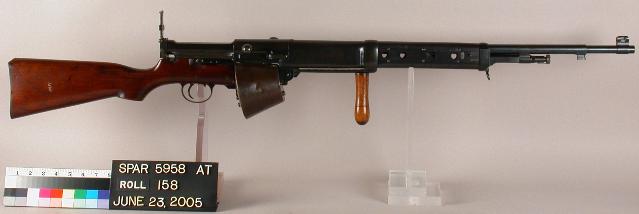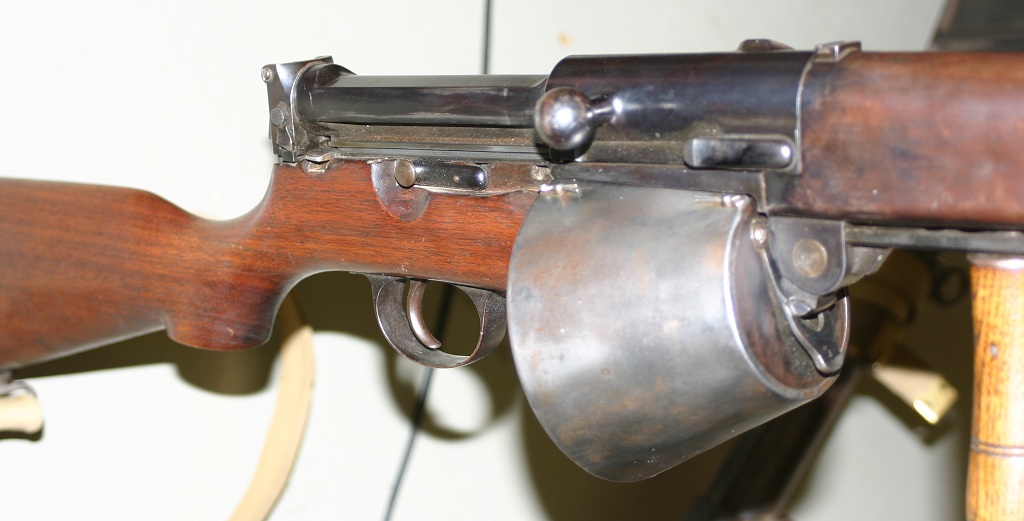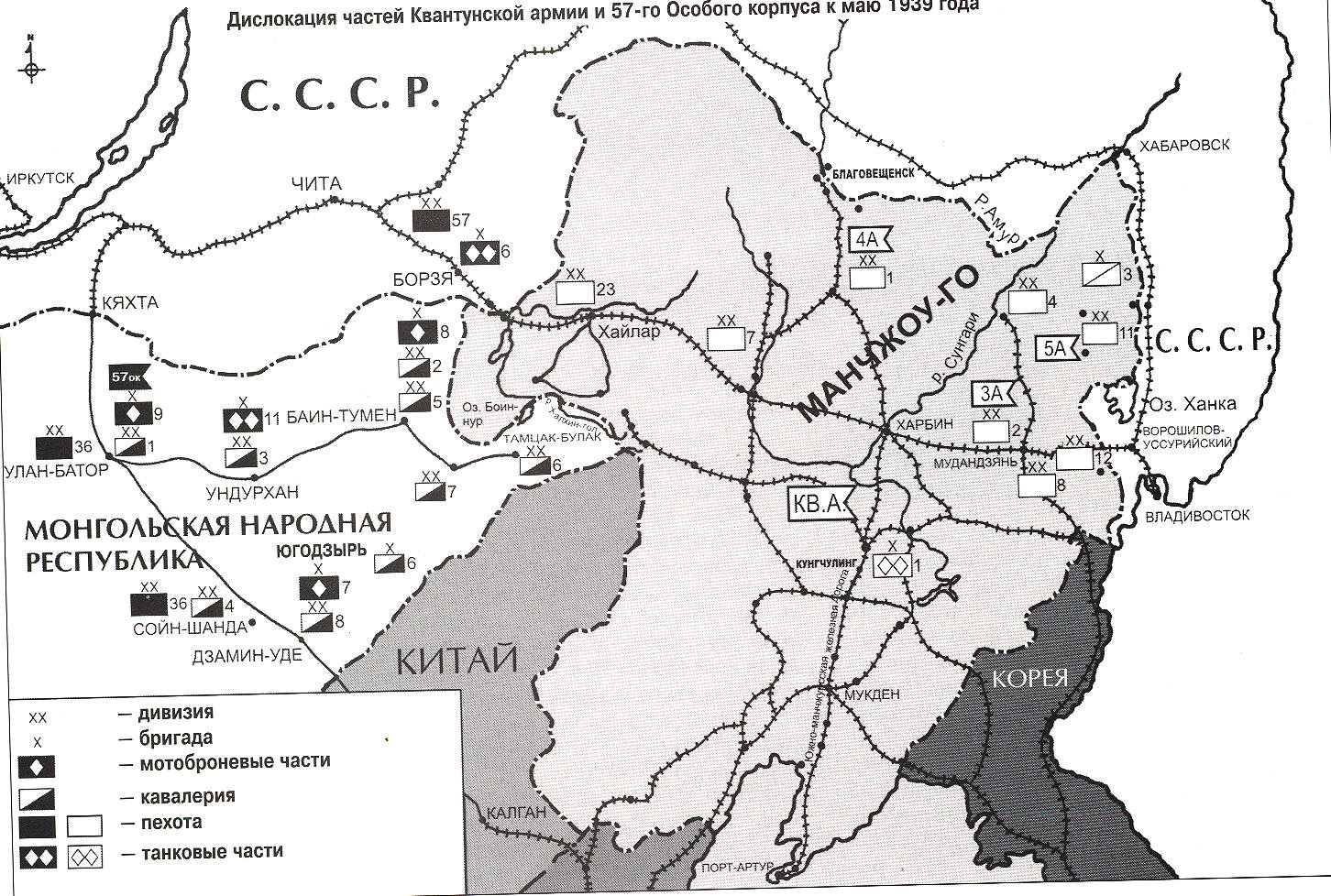Hello it is me again, and here i am to make some offers regarding small arms.
the ones to be suggested and posted existed in real life, and at the minimum as a prototype.
First of is a rifle that could have replaced the SMLE series.
Farquar-Hill Self Loading Rifle (Rifle. .303 inch, Pattern 1918)



closeup on the magazine.
Place of Origin : United Kingdom
Wars used in : WW1
Designer : Moubray G. Farquhar and Arthur H. Hill
Cartridge : .303
Action : Recoil (prototype) production model used Gas
Rate of Fire (automatic version only) : 700rpm
Feed System : 20-65 round drum magazine
Sights : Iron
The Farquhar-Hill Rifle was one of the first automatic rifles designed in the early 20th century. It was first tested in May 1908, but had many failures. Design was by Major H J Farquhar-Hill, who produced several improved designs none of which completely satisfied the Small Arms Committee. It is a British long recoil operated automatic rifle taking a .303 inch round from a 20-round drum. Magazine variations included a 10-round truncated cone and a 65-round drum. Operation is automatic with a cyclic rate of 700 rounds-per-minute. It has a muzzle velocity of 732 metres-per-second(2400 feet per second) and is sighted to 1372 metres(4500 feet). One of his rifles (or one similar to it) was tried in the United States late in the First World War using a drum type magazine.
The Farquhar-Hill appears to have been adopted and ordered by the British Army in 1918, but the end of hostilities in Europe led to the order being cancelled before and rifles were delivered. It did see some use with British aviators, along the same lines as the Mauser Selbstlader and Mondragon rifles. For observers and gunners aloft, self-loading rifles were an enormous advantage over manually operated weapons, and these early rifles were briefly used before the practice of mounting machine guns in aircraft took hold.
The Farquhar-Hill self-loading (semi-automatic) rifle was a joint development of two British gentlemen, Moubray G. Farquhar and Arthur H. Hill. Their original invention, patented in UK in 1908 and in USA in 1909, was a long-recoil operated rifle with rotary bolt locking. The key feature of this firearm was the fact that recoil energy of the moving barrel was stored in the intermediate spring. Upon discharge, barrel recoiled back and forth while still locked with the bolt, compressing the intermediate spring on recoil. Upon return of the barrel into the forward position the energy, stored in the intermediate 'action' spring, was used to cycle the bolt back and forth, extracting and ejecting the spent case and feeding a fresh round into the now stationary barrel. The main goal was to achieve smooth and reliable cycling of the bolt, but the design was very complicated and thus badly suited for a military firearm. By 1911, Farquhar and Hill revised their rifle, changing its source of energy from barrel recoil to more convenient gas operated action. This new weapon also utilized intermediate spring as a source of energy for cycling of the bolt, but the barrel was now stationary, simplifying design and making it potentially more accurate and reliable. During following years this design was further refined and tested by British Army on several occasions. This rifle was initially chambered for the new “.303 rimless” round, designed by necking up the 7,65x53mm Belgian Mauser case and loading it with British-issue Mk.VII bullet of .303 caliber. Later on this experimental loading was discarded in favor of the standard issue .303 British ammunition. After several trials, including troop trials at the front, in 1918 the Farquhar-Hill rifle was found to be suitable for military use, and an official request was issued for procurement of as much as 100,000 of Farquhar-Hill rifles for British forces fighting on the Continent against Germany. Official nomenclature assigned to the military Farquhar-Hill rifle in August 1918 was “Rifle. .303 inch, Pattern 1918”. However, hostilities of the Great War ended before production facilities were allocated for this rifle, and in the view of an upcoming peace the requirement for manufacture of Farquhar-Hill rifles was dropped in 1919. During 1920s and early 1930s Farquhar redesigned this rifle into a light machine gun of lightweight design, fed from top-mounted pan magazines. This machine gun, known as the Beardmore-Farquhar, was also tested by British army on several occasions but was ultimately rejected for variety of reasons.
and here is a lost gem from a nation that tried to recreate Mare Nostrum.
Cei-Rigotti

Type : Automatic rifle (not to be confused with a fully automatic, the term automatic comes from it being self loaded)
Place of origin : Italy
Designer : Amerigo Cei-Rigotti
Designed : 1900
Weight : 4.3 kg (9 lb 55 oz)
Length : 1,000 mm (39.4 in)
Cartridge : 6.5x52mm Mannlicher-Carcano
Action : Gas piston, self-loading
Rate of fire Up to 900rpm
Muzzle velocity : 730 m/s (2,400 ft/s)
Feed system : 25-round detachable box magazine
Sights : 1,400 meters (1,531 yards) (iron)
The Cei-Rigotti is an early automatic rifle created by Amerigo Cei-Rigotti, an officer in the Italian Army, in 1890, and extensively modified until its final form circa 1900.
It had selective fire capabilities (single shots or burst) and was a gas operated rifle. Over the next few years (1903 and 1911) there were improvements to its internal functions, such as its gas operation. The rifle fired 6.5x52mm Mannlicher-Carcano ammunition fed from a 25-round detachable box magazine. The rifle, although not actually used by any army (possibly because of its extreme unreliability), was produced in limited quantities and tested in Switzerland, Russia and Austria. These variations fired 8x56mmR (Austria) and 7.62x54mmR (Russian) ammunition.
The Cei-Rigotti was tested by the British Small Arms Committee and was also tested by the Royal Navy. The rifles experienced difficult ejection and had high rates of misfires. According to the illustrated directory of 20th century guns, it was also unpopular with troops who used it because of the distance the bolt traveled backwards in operation.
Fusil Automatique Modèle 1917

Type : Semi-automatic rifle
Place of Origin : France
Originally in Service : 1917-1926
Used by : French army (and unconfirmed reports of use by some soldiers in the Wehrmacht after the french surrender.)
Wars participated in : WW1 and the Rif War
Designer : Ribeyrolles, Sutter, Chauchat
Designed : 1917
Manufacturer : Manufacture d'armes de Tulle
Produced : from 1917 to 1918
Number built : about 86.000
Catridge : 8x50mm R Lebel
Action : Gas operated, rotating bolt
Feed system : 5-round capacity clip-fed internal box magazine
The Fusil Automatique Modèle 1917 (also called the RSC M1917) was a semi-automatic, gas-operated, infantry rifle that was placed in service in the French Army during the latter part (1918) of World War I. It was chambered in the then-standard 8mm Lebel rimmed cartridge used in other French Army infantry weapons of the time. Altogether, eighty six thousand RSC M1917 rifles had been manufactured by MAT (Manufacture d'Armes de Tulle), when their production run ended in late November 1918. However very few have survived and those are actively sought after by collectors .
The adoption of the Modèle 1917 can be traced to early attempts by the French Army to replace its Lebel rifles with a more advanced semiautomatic design in the years before the outbreak of the First World War. In 1913, a semi-automatic rifle was selected to be adopted as a replacement for the Lebels and Berthiers in the army's inventory. It was the semi-automatic long recoil operated Meunier rifle which was tentatively adopted in 1910 as a replacement for the Lebel rifle. Considerable delays were experienced in the final choice for the ammunition which ended up being a powerful rimless 7x57mm round. Only 1013 Meunier rifles had been manufactured by 1916 and about 300 were sent for field trials in the trenches. They were well received but the special ammunition problem was a major handicap.
The Mle. 1917 RSC ( for: Ribeyrolles, Sutter and Chauchat) was formally adopted in May 1916 and a fairly large number (86,000) had been manufactured by November 1918. It was less expensive to manufacture than the Meunier rifle since it used standard Lebel rifle components, notably: the barrel, stock, handguard, barrel bands and trigger guard. Above all else, it was chambered for the standard 8mm Lebel ammunition, which was loaded on special five round clips. The Mle 1917 RSC was gas operated with a rotating bolt, the gas port being located underneath the barrel and near the muzzle as in the much later to appear Garand rifle. The Mle 1917 was widely distributed among French infantry during 1918 but it was not well received by the troops, being found too heavy, too long and too difficult to service and maintain in the trenches. The weak point of this rifle was the very small inside diameter of the gas port located below the front end of the barrel. Because of its diminutive size the gas port fouled easily thus creating weaker and weaker bolt returns. As a result the gas port had to be frequently cleaned out (every 100 rounds or so) after removing the large brass screw located underneath the front end of the barrel. Furthermore, the special clip for the Mle 1917 was not particularly strong.
Following as a substantial improvement, the Mle 1918 RSC was adopted in 1918 as a rifle planned to replace all other rifles in 1919. It had a shorter barrel than the RSC 1917, all the Mle 1917 RSC drawbacks had been corrected and it used the standard and better 5-round Berthier clip instead of the proprietary clip of the RSC 1917. Its manufacture did not begin until November 1918. Only 4,000 were built and many were successfully tested in combat during the Rif War of 1921-1926 in Morocco.
Both the Mle 1917 RSC and the Meunier rifle can be seen at the Musée de l'Armée, Les Invalides, Paris, France, as a part of the permanent WW-1 (1914–1918) arms, uniforms and equipments exhibits. Within the US, excellent specimens of the Mle 1917 RSC are displayed in the collections of the public museum at Aberdeen Proving Grounds and also at the US Military Academy museum at West Point. An excellent specimen of the RSC Mle 1917 is also preserved at the National Rifle Association Museum.
ZH-29

Type : Service Rifle
Place of origin : Czechoslovakia
Used by : Republic of China, Czechoslovakia, Ethiopia, Germany and Thailand.
Designer : Vaclav Holek
Weight : 4.5kg (9.9lb)
Length : 1150mm (45in)
Barrel Length : 545mm (21.5in)
Catridge : 8x57mm IS
Calibre : 7.9mm
Action : Gas, Side swinging bolt
Rate of fire : semi/select fire
feed system : 5/10/25 round box magazine
Sights : Iron
The ZH-29 was a semi-automatic rifle developed in Czechoslovakia during the late 1920s and used by Chinese military forces. The ZH-29 is one of the first successful self loading rifles in service.
The ZH-29 is a gas operated service rifle with a locking system similar to that which would be later used in the Sturmgewehr 44.
Kongsberg Colt


Type : Semi-automatic Pistol
Place of origin : Norway
Used by : Norway and Nazi Germany
Wars : WWII
Number built : 32,874
Catridge : 11.43x23mm ACP (.45 ACP)
Calibre : .45
Action : Recoil-operated, closed bolt
Rate of fire : semi automatic (depends on how fast you can pull the trigger iow)
Muzzle Velocity : 800 ft/s (244 m/s)
Feed System : rounds (standard-capacity magazine), +1 in chamber
The Kongsberg Colt is a nickname used for Colt M1911 pistols produced under license by the Norwegian factory Kongsberg Vaapenfabrikk.
Norway adopted the 7.5 mm Nagant revolver (named M/1893) as the standard Norwegian military sidearm in 1893. Commissions to test possible new service pistols were active from 1904 till 1911. In 1911, a commission recommended adoption of the semi-automatic .38 ACP caliber Colt Military Model 1902 pistol, after field trials with 25 such pistols, all purchased from Colt's London Agency. However, as the US had just adopted the Colt .45ACP M/1911 pistol it was decided to conduct further tests. A pistol of the new M/1911 design was received in Norway in January 1913. Following extensive tests through early 1914, if was finally decided, in August 1914, to adopt the Colt M/1911 pistol in Norway. These pistols were to replace the Nagant revolvers (7,5mm M/1893) as the standard military sidearm in Norway. Fabrique Nationale in Belgium signed a contract allowing Norway to manufacture the M1911 in September 1914. The pistol would be produced at Kongsberg Vaapenfabrikk in Norway.
As production start was slow, some M1911's were bought from Colt USA. 400 pistols were shipped to Norway for the Royal Norwegian Navy in 1915, 300 more pistols were shipped in 1917 for the Norwegian Army. Price was US$18.50 per piece.
The production at Kongsberg Våpenfabrikk in Norway started in 1916 and 95 pistols were finished in 1917 and wrongly stamped "COLT AUT. PISTOL M/1912" These pistols were identical to the Colt M1911 except for a minor detail on the hammer checkering. 100 pistols were ordered, but 5 were rejected during production. The serial range was from 1 to 95. Number 1 is in Bady's book "Government Models" and number 2 was stolen from Norwegian Armed Forces Museum in 1978.
Kongsberg Våpenfabrikk was ready to start mass production in 1918. One significant change was now made. The slide-stop was extended down and back to make it easier to operate. This change required a cut-out in the left stock. This change had been suggested in 1916, but did not materialize on the production pistols before in 1918. The new version had the left side of the slide stamped "11.25 m/m AUT. PISTOL M/1914." (AUT.= Automatisk) that was correct as the adoption of the gun was in 1914. Most of the pistols that had been marked "1912" were recalled to the factory to have the "new" slide stop installed. Production went on, but from 1932 to 1939 the production was very low, only 871 were made (approx 22,300 pieces were made before 1940).
During the German occupation of Norway (1940–1945), manufacture of the pistol, given the designation Pistole 657(n), was continued under German control. The Waffenamt acceptance mark (WaA84) was added in 1945 and only those 920 pistols produced that year were ever Waffenamt-marked. It's not likely that any of these Waffenamt-marked pistols ever saw any action during World War II as the first one, serial# 29615, was delivered March 29, 1945 and the last one, serial# 30534, was delivered on 5 May 1945 just before liberation of Norway. In total, approximately 8200 pistols were made during German occupation (serials 22312-30534). All of them were delivered to AOK Norwegen (Army) except 700 that were delivered to Maza Norwegen (Navy).
Occupation production:
1940 = approx. 50 pistols
1941 = approx. 4099 pistols
1942 = 3154 pistols
1945 = 920 pistols
No pistols were produced in 1943 & 1944. In those years, production of Krag-Jørgensen rifles was prioritized.
A few pistols were assembled from existing parts after the war until production was halted at serial number 32854 in 1947. Twenty additional pistols were assembled from foreign-produced parts in 1987 as collector's pieces for the US market. A US dealer supplied commercial frames, slides and barrels as well as other parts that were assembled at Kongsberg. Previous markings were removed and Kongsberg markings and serials were engraved on the parts before the assembled pistols were returned to the US.
this post will be updated with information of more weapons.










